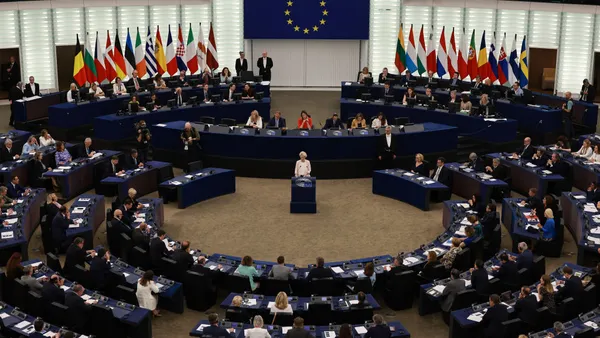Dive Brief:
-
The U.S. Postal Service will acquire and use at least 66,000 battery electric vehicles by 2028, the agency announced Tuesday. No less than 45,000 of those vehicles will be electric versions of the Postal Service’s next-generation delivery vehicles.
-
The effort is part of the Postal Service’s $9.6 billion plan to replace its aging fleet of over 220,000 vehicles. The new delivery vehicles will start hitting the streets by the end of 2023, the agency stated. The Postal Service will buy 106,000 new vehicles, including EVs, by 2028 and, come 2026, all next-generation vehicles delivered will be electric.
-
Postmaster General Louis DeJoy said in a statement that the passage of the Inflation Reduction Act gave the Postal Service the funding it needed to go electric. “The $3 billion provided by Congress has significantly reduced the risk associated with accelerating the implementation of a nationwide infrastructure necessary to electrify our delivery fleet,” he said.
Dive Insight:
The agency’s actions align with federal, state and local government initiatives to decarbonize the transportation sector.
The Postal Service initially unveiled its delivery fleet replacement plan in 2021 but was criticized by the White House, environmentalists and others because only 10% of the vehicles would have been electric.
In February, the U.S Environmental Protection Agency said the plan was out of step with President Joe Biden’s climate agenda and called on the Postal Service to conduct a new environmental review. Biden signed an executive order in December 2021 calling for most federal vehicle purchases to be zero-emission by 2035 but excluded the Postal Service, according to the U.S. Government Accountability Office.
The Postal Service announced in March that it would buy 50,000 new delivery vehicles from contractor Oshkosh Defense, with at least 20% being electric. In July, the agency said it would conduct a new environmental impact analysis and that at least half its new delivery vehicles would be electric. The Postal Service also said in July that it would buy an additional 34,500 EVs from other automakers.
In Tuesday’s press release, the agency defended its original decision, saying it “was expressly designed to provide the Postal Service the flexibility to acquire significantly more [electric delivery vehicles] should financial and operational circumstances permit.” Funding from the IRA allowed the Postal Service to make that commitment, DeJoy said.
EV advocates are celebrating the Postal Service’s latest electrification efforts.
“The U.S. federal fleet is the largest vehicle fleet in the world, and the USPS delivery fleet is the largest and most recognizable fleet within that,” said Ben Prochazka, executive director of the Electrification Coalition Executive Director, an EV advocacy group, in a statement. “This move further signals that electricity will power not only the next generation of passenger vehicles but also medium- and heavy-duty vehicles.”
In addition to buying new vehicles, the Postal Service will attempt to reduce greenhouse gas emissions by streamlining operations.
“What is less widely understood is that our network modernization initiative is necessary to enable this vehicle electrification and will also provide meaningful cost and carbon reductions in other ways,” DeJoy said in a statement. “A key focus of our modernization effort is to reduce inefficient transportation and improve distribution operations, resulting in far less air cargo and far fewer truck trips.”
The Postal Service will publish a draft of its new environmental impact statement by May, according to the press release.















